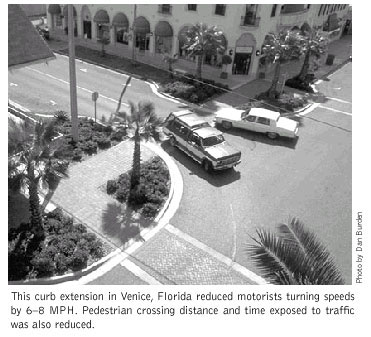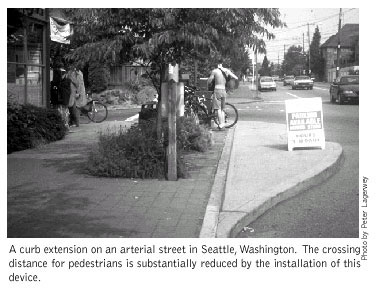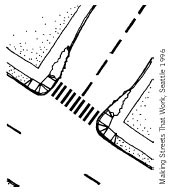23. Curb Extensions
Curb extensions - also known as bulb-outs or neckdowns extend the sidewalk or curb line out into the parking lane, which reduces the effective street width. Curb extensions significantly improve pedestrian crossings by reducing the pedestrian crossing distance, improving the ability of pedestrians and motorists to see each other, and reducing the time that pedestrians are in the street.
Curb extensions placed at an intersection essentially prevent motorists from parking in or to close to a crosswalk or from blocking a curb ramp. Motor vehicles parked at corners present a threat to pedestrian safety, as they block sight lines, obscure visibility of pedestrians and other vehicles, and make turning particularly difficult for emergency vehicles and trucks. Motorists are encouraged to travel more slowly at intersections or midblock locations with curb extensions, as the restricted street width sends a visual cue to motorists. Turning speeds at intersections are reduced with curb extensions (curb radii should be as tight as is practicable).
Curb extensions are only appropriate where there is an on-street parking lane. Curb extensions must not extend into travel lanes, bicycle lanes or shoulders). The turning needs of larger vehicles such as school buses need to be considered in curb extension design.



Purpose:
- Improves safety for pedestrians and motorists at intersections; increases visibility and reduces speed of turning vehicles.
- Encourages pedestrians to cross at designated locations.
- Prevents motor vehicles from parking at corners.
Considerations:
- Curb extensions should typically be used where there is a parking lane, and where transit and cyclists would be traveling outside the curb edge for the length of the street.
- Midblock extensions provide an opportunity to enhance midblock crossings. Care should be taken to insure that street furniture and landscaping do no block motorists view of pedestrians
- Where intersections are used by significant numbers of trucks or buses, the curb extensions need to be designed to accommodate them. However, it is important to take into consideration that those vehicles should not be going at high speeds, and most can make a tight turn at slow speeds. It is also not always necessary for a roadway to be designed so that a vehicle be expected to turn from right lane to right lane -i.e., the vehicles can often encroach into adjacent lanes safely where volumes and/or speeds are slow. Keep in mind that speeds should be slower in a pedestrian environment.
- Emergency access is often improved through the use of curb extensions, as intersections are kept clear of parked cars. Fire engines and other emergency vehicles can climb a curb where they would not be able to move a parked car. In addition, at mid-block locations, curb extensions can keep fire hydrants clear of parked cars and make them more accessible.
- Curb extensions can be used to place landscaping and street furniture; this is especially beneficial where sidewalks are otherwise too narrow.
Estimated Cost
Curb extensions cost from $2,000 to $20,000 per corner, depending on design and site conditions. Drainage is usually the most significant determinant of costs. If the curb extension area is large and special pavement and street furnishings and planting are included, costs would also be higher. Costs can go up significantly if something major such as a mast arm or controller box is moved.